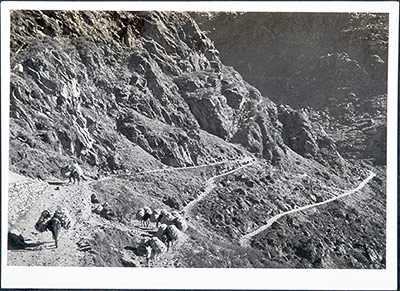
1999.23.1.6.1 (Album Print black & white)


1999.23.1.6.1 (Album Print black & white)

H. Staunton ?
Harry Staunton
1940 - 1941
Chumbi Valley Region > Jelap La
1999.23.1.6.1
119 x 87 mm
Print gelatin silver
Donated 1999
Diana Hughes
H. Staunton
Diana Hughes
Notes on print/mount - "Wool train and typical track" is written on the reverse of the print in pencil. Also, the number "4258" is written in pencil in the top right hand corner. [KC 7/12/2005]
Manual Catalogues - "Jelap La Pass". [Hugh Richardson in conversation with Roger Croston, detailed in H. Staunton undated Related Documents File, PRM Manuscript Collections]
Other Information - Setting: F Spencer Chapman writes in Lhasa: The Holy City , London: Readers Union Ltd, 1940, p. 15, "The main Lhasa-India trade route, together with the telegraph line, goes to Kalimpong in the extreme north of Bengal. This route crosses the southern ridge of the Himalaya by the Jelep La, a pass slightly higher and much more difficult than the Natu La, which descends directly to Gangtok. ... Thus it is that the bulk of the Tibetan trade, more especially the wool traffic, goes to Kalimpong, leaving the shorter Natu La track comparitively free."
Other Information - Album: This image appears in Staunton's personal album on a page (1999.23.1.6) with three other images. [KC 6/12/2005]
For Citation use:
The Tibet Album.
"Mountain trail leading up to the Jelap La pass"
05 Dec. 2006. The Pitt Rivers Museum.
<http://tibet.prm.ox.ac.uk/photo_1999.23.1.6.1.html>.
For more information about photographic usage or to order prints, please visit the The Pitt Rivers Museum.
© The Pitt Rivers Museum